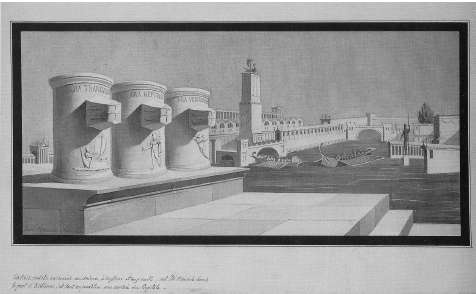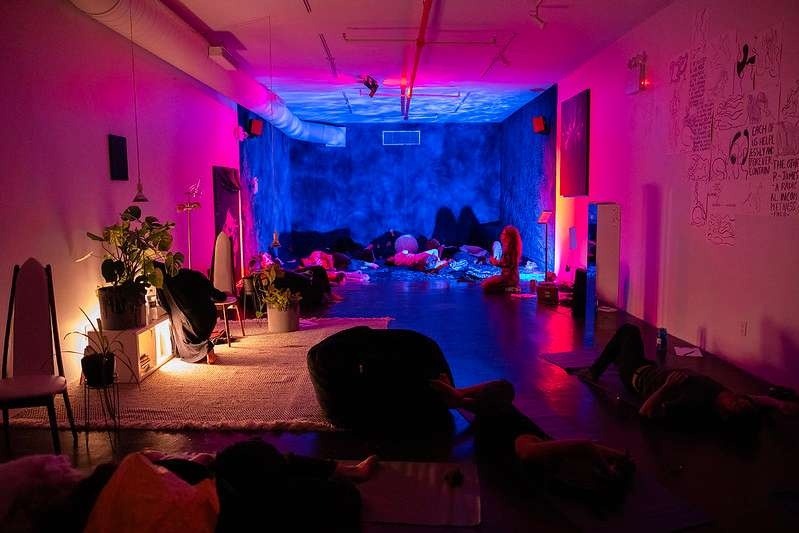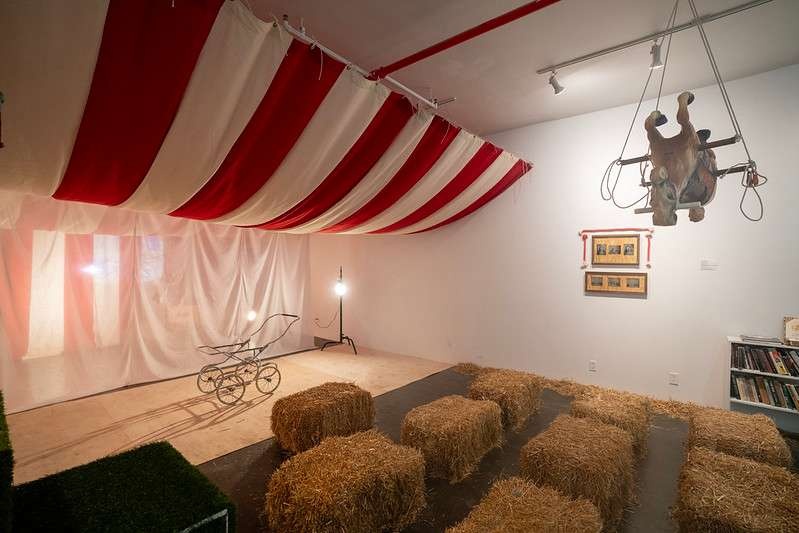I. Vessel and frame
A pavilion is an interceptor. It breaks the flow of the environment, providing a threshold into an alternate space or time. It need not be a weatherproof enclosure; its primary role is to open a new vector of experience. A pavilion may hold nothing but a proposition—but a pro-position may re-position the things or people that touch it.
Among architectural types, the pavilion is perhaps the most volatile. As a temporary, exhibitionary structure, it is free from the traditional burdens of function and durability. It is a space of inventing and forgetting, experimentation and fiction—a magic circle in which we play by different rules. Pavilions at World’s Fairs were presented as harbingers of the future, or as windows into foreign civilizations. Architectural innovations in open-plan layouts, multi-media immersion, and tensile structures all made an early appearance in the form of a pavilion.
Chameleon-like in its flexibility, the archetypal pavilion acts as a frame rather than a container. The space within may be wide open, yet it is not neutral. It is charged with transformative potential. The pavilion, alien to its site, seems to arrive from the air, and is always ready to take off. This vessel masquerades as a room or a building, allowing you to approach or even enter it—but it remains a contrivance for transport. It is designed to intercept. Dan Graham’s pavilions, for example, intercept our experience of a place by setting up ambiguous spatial scenarios in which inside folds into outside, public dissolves into private, and transparency hardens into reflection.
Implanted within the frame of the gallery, John Miserendino’s Pavilion intercepts the traces of four other projects, including an apocryphal plan of the pavilion itself. It proceeds via a series of leaps and permutations to incubate these intercepted elements into something altogether new. Part stage, part laboratory, and part recording studio, this polyvalent hut frames open-ended creative acts. It opens a space of contingency in which various abandoned and ‘complete’ works discover that they were never really finished. Under the intoxicating spell of the pavilion, the ancestors of a Bierstadt painting, a Dan Graham sketch, a Spiderman costume, a Sonic Youth album, and a Michael Haneke film cross paths and produce offspring that little resemble the ones they dreamed of.
II. Hot Fragments
Each interception begets a tangential dash that puts cold material back into hot play. Rediscovered and remixed out of context, the fragments become fertile. They serve as generative elements in a process of fictive reconstruction. Fictive reconstruction is not the same as restoration, nor is it pastiche. It is different from simulacrum, replica, and parody. It presents rather than represents. It is more about making than faking.
The gleaner-artist, hunting resourcefully along the margins of mainstream production, sees raw material where others see only empty scraps and dead-ends. This raw material need not even be material in the physical sense. It can appear in the form of things that might have been.
As the art historian Vittoria Di Palma has observed, “the recombination of a number of individual fragments can produce a new entity, a different work that lays claim to its own completeness.” Unlike a reconstructed statue, which “gestures back towards a once-perfect original,” a work inspired by salvaged bits and pieces “gestures forward to ever more reorganizations, none of them authoritative, all equivalently contingent.” This work remains continually open to reinvention, so long as it retains a sense of its own incompletion. [1]
III. Fictive Reconstructions: Port, cathedral, garden
The process of fictive reconstruction is exemplified in a remarkable drawing from 1828 by the French architect Henri Labrouste. While studying abroad in Rome, the young Labrouste made a detailed study of the Three Altars from the vanished port of Antium. Housed in the Museum of the Capitoline, the three great stone cylinders were all that remained of a once-prominent sea town of the Roman empire. On the basis of these isolated monuments alone, Labrouste conjured a convincingly detailed perspective view of the entire port (fig. 1). [2]


Figure 1. Henri Labrouste, Fragments antiques, 1828. Avery Library, Columbia University.
In 1845, the year in which construction began on Labrouste’s masterful Bibliothèque Sainte-Geneviève in Paris, a project which pioneered the use of iron in a civic building; another influential French architect, Viollet-le-Duc, was entrusted with the restoration-rescue of the cathedral of Notre-Dame de Paris. Viollet-le-Duc took a radically interpretive approach to the restoration, which continued for decades. He not only had the cathedral repaired and cleaned, but he “finished” it by adding a huge spire over the crossing of the nave and transept. And after faithfully restoring the original gargoyle water spouts, which date from c.1225, he took the liberty to add a series of purely decorative new chimères, or grotesque figures, reminiscent of Daumier’s caricatures.[3] According to the architect’s logic, the medieval gothic tradition was made more intact, more whole, through a series of deft additions. To see the cathedral as a body of hot fragments, however, was a privilege reserved for the architect. To everyone else the work is supposed to appear closed and complete.
Pavilions have often been sited in gardens, and gardens themselves have been key sites of fictive reconstruction. Each age reinvents nature for itself—ordered and harmonious here, wild and woolly there, threatening, sacred, or just decorative. Landscapes blur the line between found and made. In New York City the landscapes of Central Park, the High Line, and Teardrop Park embody the complex genius of fabricated nature. Each of these projects builds upon specific aspects of the given topography, and then exceeds that topography through ambitious design.
In the early days of the so-called English landscape garden, in which regular geometries were replaced with gentle curves, artful garden designers availed themselves of hot fragments. A passage from the 1st century A.D. writer Pliny the Younger, for example, was used to justify a heightened correspondence between pictures and picturesque gardens in the 18th century. “You could scarce believe you were looking upon a real country, but a landscape painting drawn with all the beauties imaginable,” wrote Pliny of his bucolic Tuscan villa garden (ital. added). One Robert Castell, inspired by Pliny’s vague descriptions, ventured to create a carefully delineated plan for the lost garden, including large areas intended to evoke a painting. But what kind of painting? The upper left and right segments of the ground plan reflect the latest 18th-century fashion in naturalistic squiggles, clumps, and meanders. [4] Inventing the past is a conceit for projecting into the future. (fig. 2)


Figure 2. Robert Castell, frontispiece to The Villas of the Ancients Illustrated, 1728. The sections to the upper left and right are interpretations based on vague historic evidence.
Artists remind us that the world remains open and unfinished. Just as the land and skies do not hold still, neither, it turns out, do some projects that would appear to be finished, lost, or tossed out. When it comes to creative interceptions, the reanimation of fragments comes from the slippage between reconstruction and fiction.
Footnotes
-
Vittoria Di Palma, “Fragmentation, Multiplication, Permutation: Natural Histories and Sylvan Aesthetics from Bacon to Evelyn,” in Barry Bergdoll and Werner Oechslin, eds., Fragments: Architecture and the Unfinished. Essays Presented to Robin Middleton (New York: Thames & Hudson, 2006), p. 233.
-
See Barry Bergdoll, “‘… en general de tres honnetes rebelles.’ Fragmentary notes on a newly discovered album on French Romantic architectural compositions,” in Ibid., pp. 213, 221.
-
See Eugène Emmanuel Viollet‐le-Duc, Monographie de Notre-Dame de Paris (1853), and Description de Notre-Dame, cathédrale de Paris (1856). With thanks to Ariel Genadt for locating the sources and providing historical background on the project
-
See John Dixon Hunt, The Picturesque Garden in Europe (New York: Thames & Hudson, 2002), p. 20. Also Pierre de la Ruffinière Du Prey, Villas of Pliny from Antiquity to Posterity (Chicago: University of Chicago Press, 1994), 26.
About the artist
Gideon Fink Shapiro
Gideon Fink Shapiro writes about architecture, art, and landscapes. Keenly interested in urban public space and performance, he has also participated in numerous design projects. He has worked for the New York-based design firm Gabellini Sheppard Associates, collaborated on public art projects with Amorphic Robot Works and composer Simon Fink, assisted the curator Aaron Betsky, and edited the Domus Architecture Guide to New York. His writing has been published in DomusWeb, Architect, Abitare, Journal of the Society of Architectural Historians, BMW Guggenheim Lab blog, Crit, ForYourArt, Gothamist, and Streetsblog. A graduate of Columbia University, he is currently pursuing a Ph.D. in Architecture at the University of Pennsylvania School of Design.
Projects
Explore/Archive
See allDecember 2025
The INSTITUTE FOR TRANSHUMANIST CEPHALOPOD EVOLUTION and Learning from Octopuses
Barbara London
Barbara London reflect's of Miriam SImun's INSTITUTE FOR TRANSHUMANIST CEPHALOPOD EVOLUTION
October 2025
streamlined reflections, courtesy of noise canceling headphones
Gabrielle Rucker
Gabrielle Rucker reflects on the radical intimacy and auditory life at the heart of Deli Radio
July 2025
Tell My Jockey: CUNTRY’s Discourse From the Horse’s Mouth
Ericka Pérez
Assembly fellow Ericka Pérez reflects on clowning, resistance, and CUNTRY’s radical refusal to perform.





